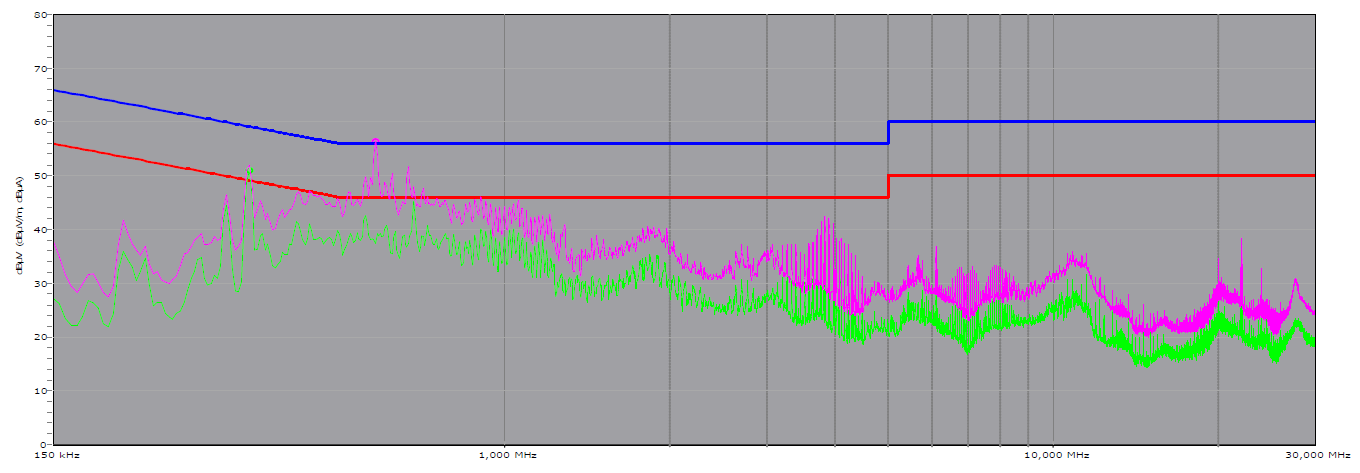Why you can trust Tom's Hardware
Advanced Transient Response Tests
For details about our transient response testing, please click here.
In the real world, power supplies are always working with loads that change. It's of immense importance, then, for the PSU to keep its rails within the ATX specification's defined ranges. The smaller the deviations, the more stable your PC will be with less stress applied to its components.
We should note that the ATX spec requires capacitive loading during the transient rests, but in our methodology, we also choose to apply a worst case scenario with no additional capacitance on the rails.
Advanced Transient Response at 20% – 200ms
| Voltage | Before | After | Change | Pass/Fail |
|---|---|---|---|---|
| 12V | 12.085V | 11.998V | 0.72% | Pass |
| 5V | 4.996V | 4.903V | 1.86% | Pass |
| 3.3V | 3.325V | 3.195V | 3.91% | Pass |
| 5VSB | 5.069V | 5.013V | 1.10% | Pass |
Advanced Transient Response at 20% – 20ms
| Voltage | Before | After | Change | Pass/Fail |
|---|---|---|---|---|
| 12V | 12.085V | 11.958V | 1.05% | Pass |
| 5V | 4.996V | 4.884V | 2.24% | Pass |
| 3.3V | 3.325V | 3.169V | 4.69% | Pass |
| 5VSB | 5.069V | 5.018V | 1.01% | Pass |
Advanced Transient Response at 20% – 1ms
| Voltage | Before | After | Change | Pass/Fail |
|---|---|---|---|---|
| 12V | 12.085V | 11.975V | 0.91% | Pass |
| 5V | 4.996V | 4.885V | 2.22% | Pass |
| 3.3V | 3.325V | 3.165V | 4.81% | Pass |
| 5VSB | 5.069V | 5.019V | 0.99% | Pass |
Advanced Transient Response at 50% – 200ms
| Voltage | Before | After | Change | Pass/Fail |
|---|---|---|---|---|
| 12V | 12.078V | 12.003V | 0.62% | Pass |
| 5V | 4.991V | 4.892V | 1.98% | Pass |
| 3.3V | 3.319V | 3.182V | 4.13% | Pass |
| 5VSB | 5.035V | 4.977V | 1.15% | Pass |
Advanced Transient Response at 50% – 20ms
| Voltage | Before | After | Change | Pass/Fail |
|---|---|---|---|---|
| 12V | 12.077V | 11.952V | 1.04% | Pass |
| 5V | 4.991V | 4.875V | 2.32% | Pass |
| 3.3V | 3.319V | 3.157V | 4.88% | Pass |
| 5VSB | 5.035V | 5.000V | 0.70% | Pass |
Advanced Transient Response at 50% – 1ms
| Voltage | Before | After | Change | Pass/Fail |
|---|---|---|---|---|
| 12V | 12.077V | 11.967V | 0.91% | Pass |
| 5V | 4.991V | 4.875V | 2.32% | Pass |
| 3.3V | 3.320V | 3.156V | 4.94% | Pass |
| 5VSB | 5.034V | 4.986V | 0.95% | Pass |

Results 25-29: Transient Response

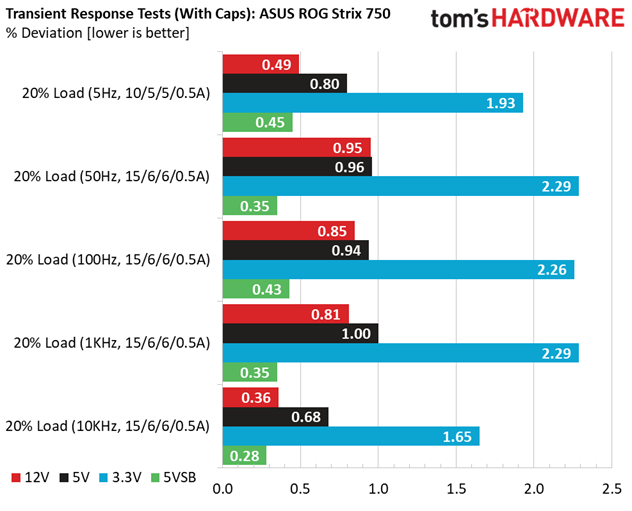
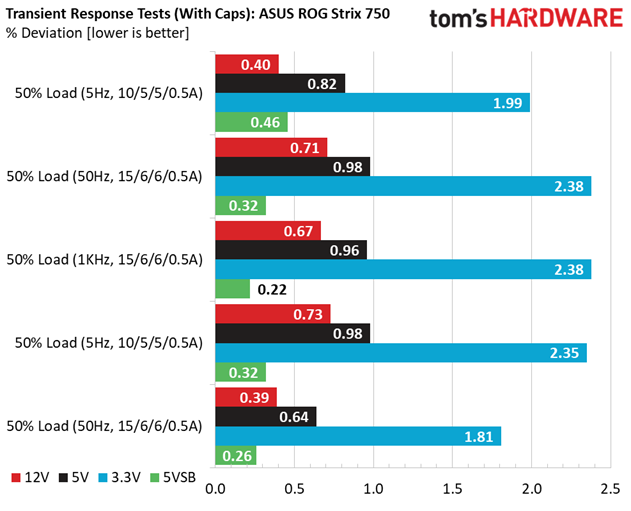

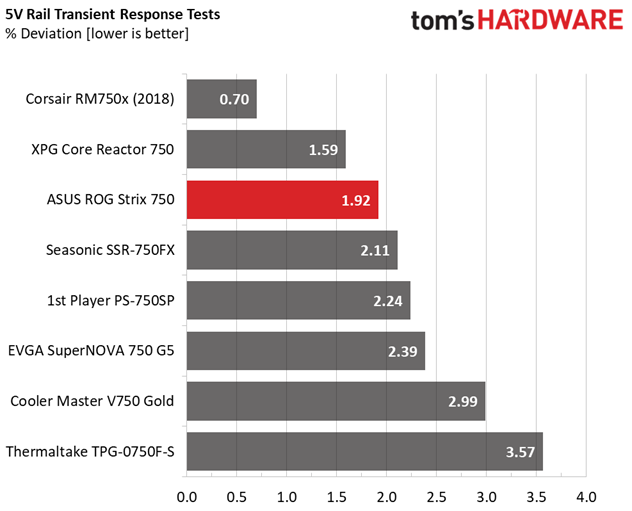
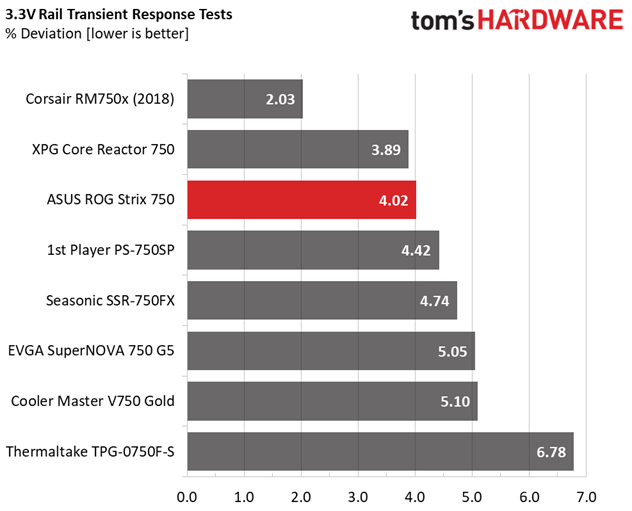
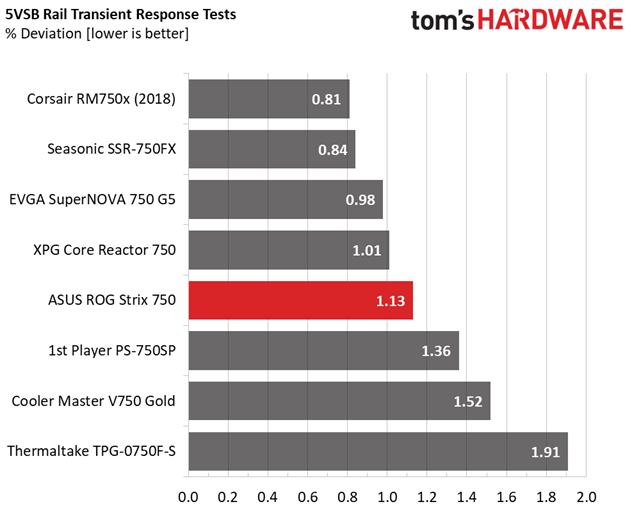
The transient response of the +12V rail, which is the most important, is excellent, and the same goes for 5VSB. The 5V rail has satisfactory performance, while there is room for improvement at 3.3V, where the voltage level dropped below 3.2V, in all tests.
Turn-On Transient Tests
In the next set of tests, we measure the PSU's response in simpler transient load scenarios—during its power-on phase. Ideally, we don't want to see any voltage overshoots or spikes since those put a lot of stress on the DC-DC converters of installed components.

Turn-On Transient Response Scope Shots

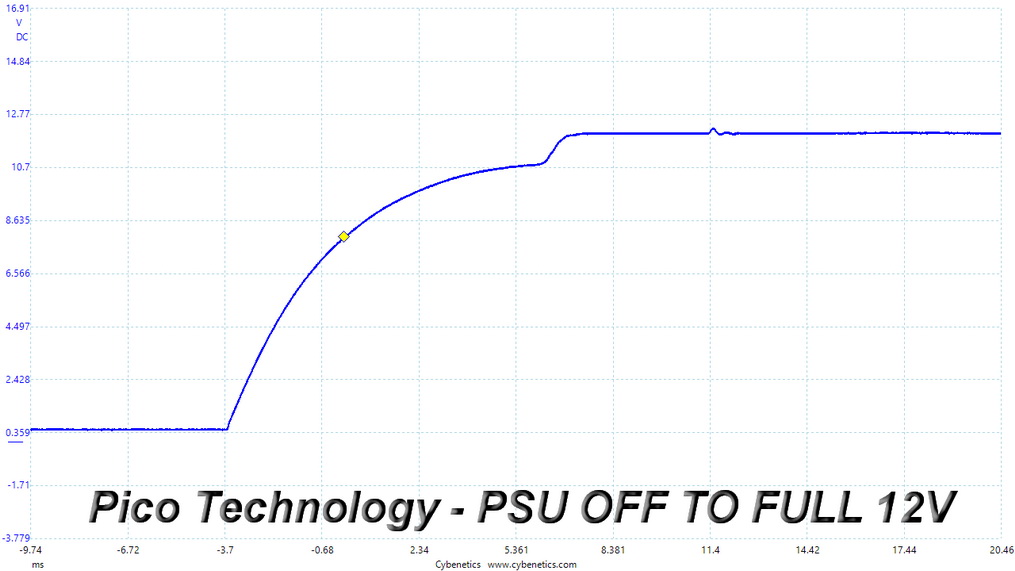
Typically for a Seasonic Focus-based platform, the +12V rail requires some time till it reaches the nominal voltage. There is nothing to worry about, though.
Power Supply Timing Tests
There are several signals generated by the power supply, which need to be within specified, by the ATX spec, ranges. If they are not, there can be compatibility issues with other system parts, especially mainboards. From year 2020, the PSU's Power-on time (T1) has to be lower than 150ms and the PWR_OK delay (T3) from 100 to 150ms.
Get Tom's Hardware's best news and in-depth reviews, straight to your inbox.
| T1 (Power-on time) & T3 (PWR_OK delay) | ||
|---|---|---|
| Load | T1 | T3 |
| 20% | 82ms | 318ms |
| 50% | 100ms | 318ms |
The PWR_OK delay is out of the 100-150ms region, so the PSU does not support the alternative sleep mode, which is a requirement by the newest ATX spec.
Ripple Measurements
Ripple represent the AC fluctuations (periodic) and noise (random) found in the PSU's DC rails. This phenomenon significantly decreases the capacitors' lifespan because it causes them to run hotter. A 10-degree Celsius increase can cut into a cap's useful life by 50%. Ripple also plays an important role in overall system stability, especially when overclocking is involved.
The ripple limits, according to the ATX specification, are 120mV (+12V) and 50mV (5V, 3.3V, and 5VSB).
| Test | 12V | 5V | 3.3V | 5VSB | Pass/Fail |
| 10% Load | 11.8 mV | 8.6 mV | 12.7 mV | 6.1 mV | Pass |
| 20% Load | 15.4 mV | 9.6 mV | 14.7 mV | 6.2 mV | Pass |
| 30% Load | 17.3 mV | 10.4 mV | 16.0 mV | 6.8 mV | Pass |
| 40% Load | 19.5 mV | 11.6 mV | 18.2 mV | 7.5 mV | Pass |
| 50% Load | 19.9 mV | 11.2 mV | 19.8 mV | 7.8 mV | Pass |
| 60% Load | 16.9 mV | 11.1 mV | 22.0 mV | 9.4 mV | Pass |
| 70% Load | 15.9 mV | 11.5 mV | 22.5 mV | 10.4 mV | Pass |
| 80% Load | 16.5 mV | 11.5 mV | 17.5 mV | 11.4 mV | Pass |
| 90% Load | 17.9 mV | 11.8 mV | 17.9 mV | 13.0 mV | Pass |
| 100% Load | 29.1 mV | 12.8 mV | 20.3 mV | 14.2 mV | Pass |
| 110% Load | 32.3 mV | 12.9 mV | 22.3 mV | 14.4 mV | Pass |
| Crossload 1 | 18.6 mV | 11.5 mV | 19.1 mV | 6.8 mV | Pass |
| Crossload 2 | 28.5 mV | 10.8 mV | 20.0 mV | 12.3 mV | Pass |
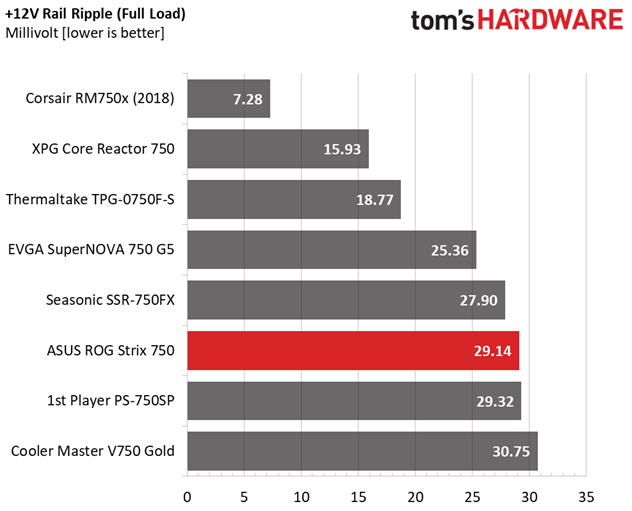
Results 30-33: Ripple Suppression



The ripple at +12V with full load increases significantly, still it remains below 30mV. All in all, the ripple suppression is good on all rails, but nowhere close to the amazing levels that the Corsair RM750x model achieves, thanks to the good design and the in-cable caps.
Ripple At Full Load
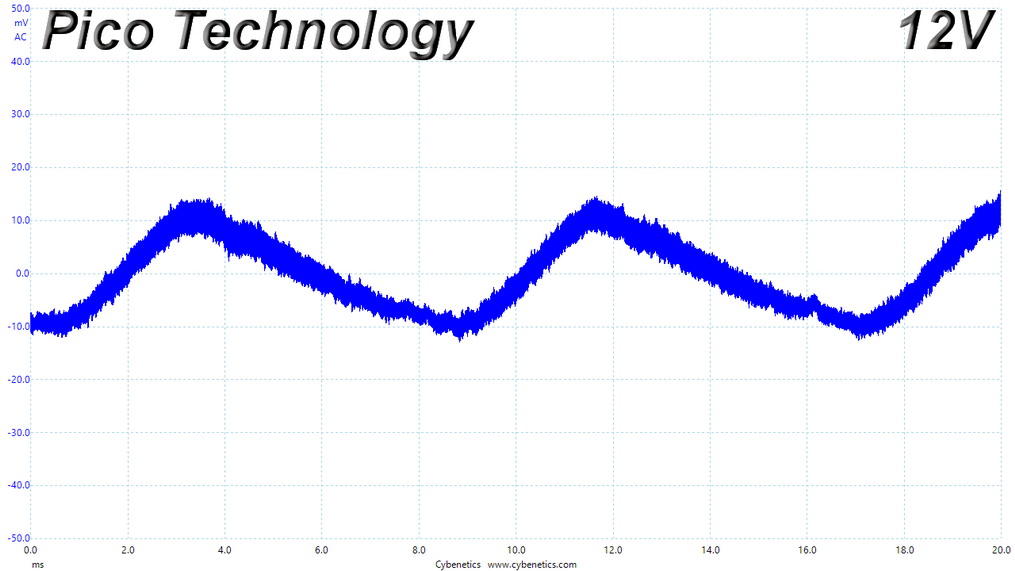
Ripple Full Load Scope Shots
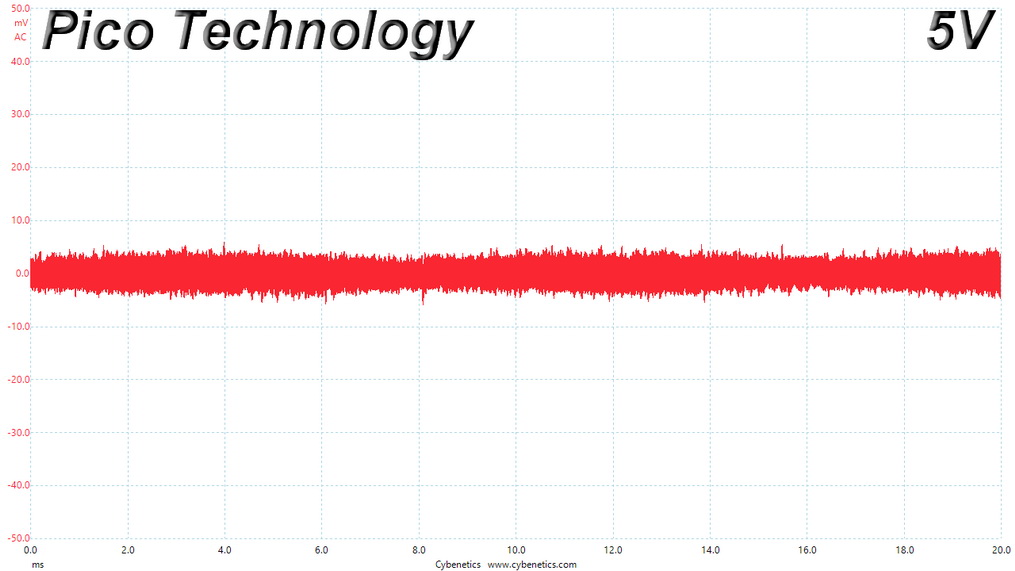


Ripple At 110% Load
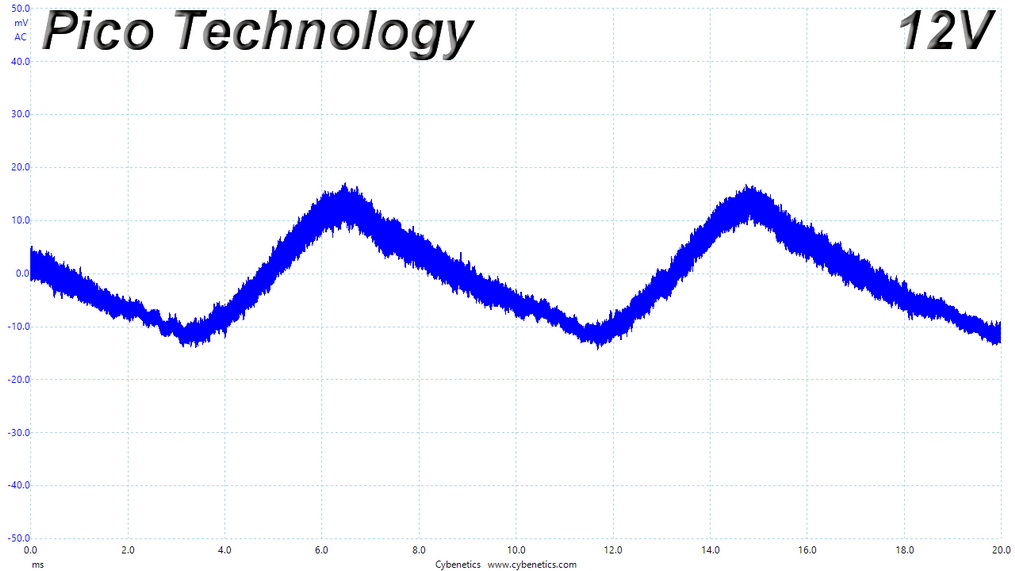
Ripple 110% Load Scope Shots
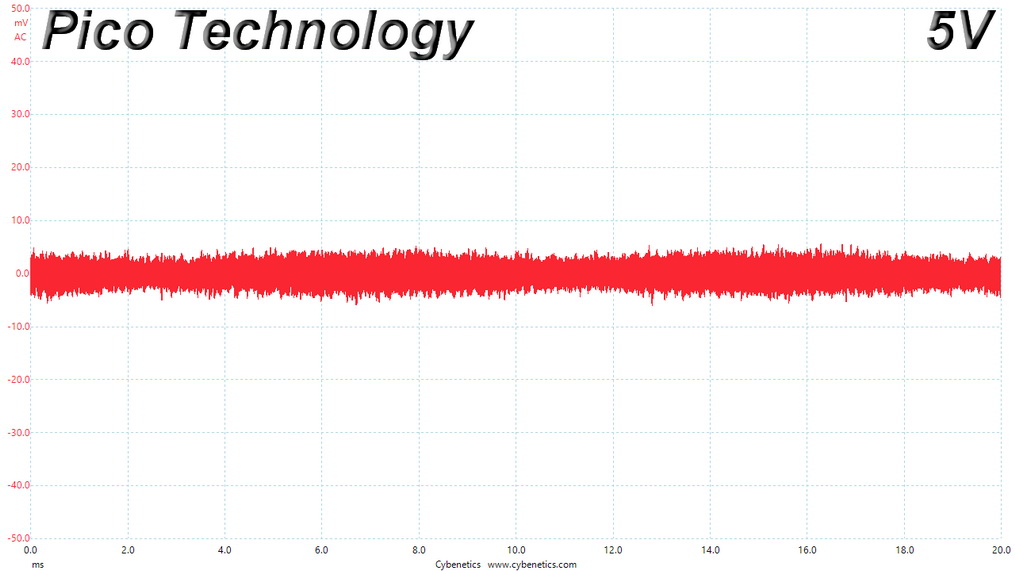


Ripple At Cross-Load 1
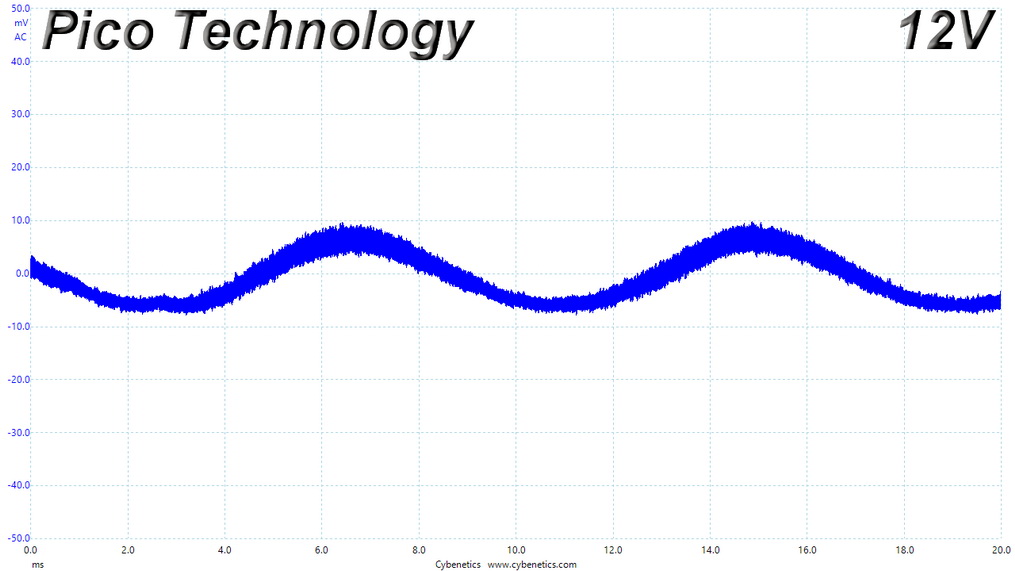
Ripple CL1 Load Scope Shots



Ripple At Cross-Load 2
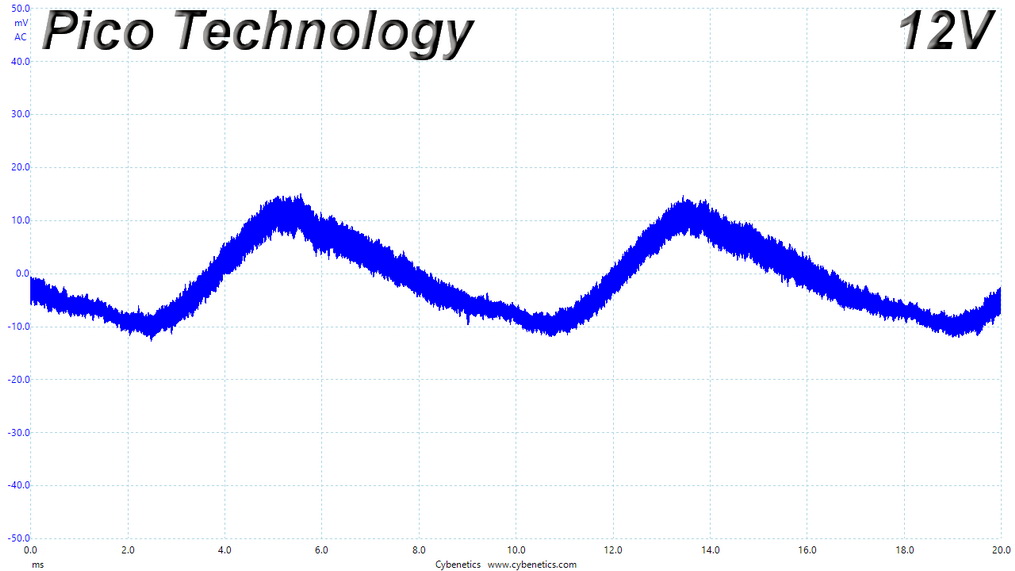
Ripple CL2 Load Scope Shots
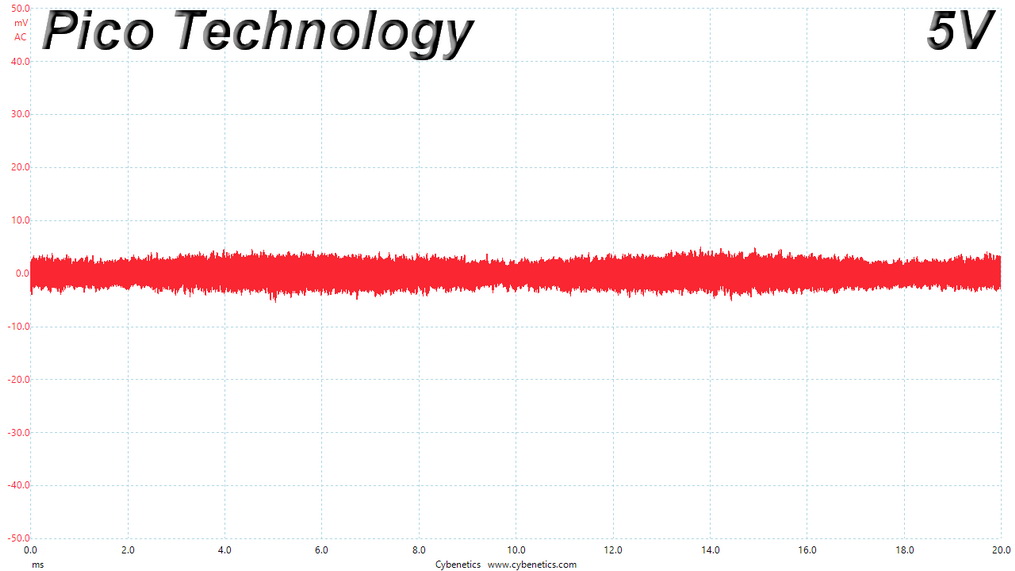

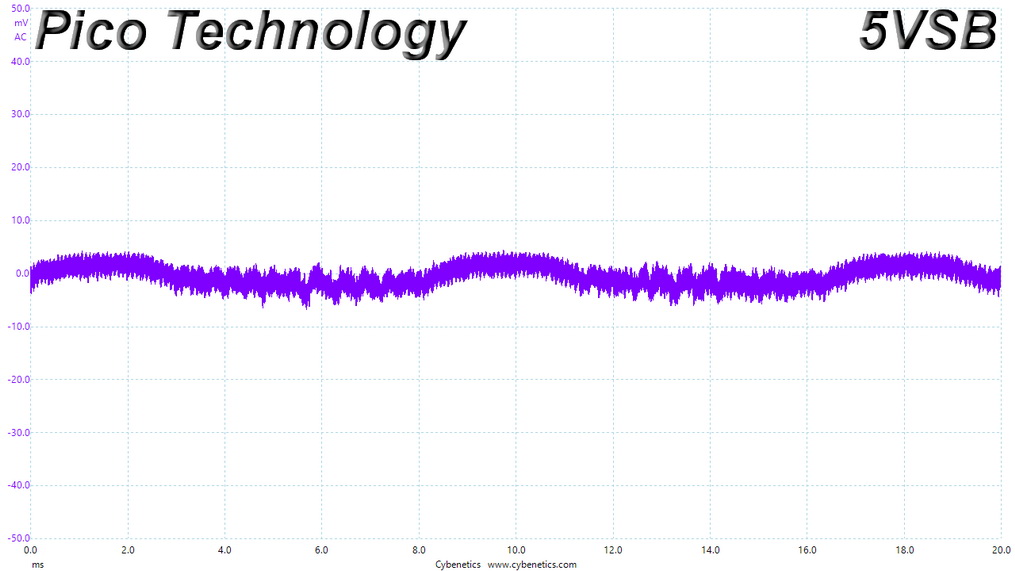
EMC Pre-Compliance Testing – Average & Quasi-Peak EMI Detector Results
Electromagnetic Compatibility (EMC) is the ability of a device to operate properly in its environment without disrupting the proper operation of other nearby devices.
Electromagnetic Interference (EMI) stands for the electromagnetic energy a device emits, and it can cause problems in other nearby devices if too high. For example, it can be the cause of increased static noise in your headphones or/and speakers.
Two high spurs exceed the limits with the average and the QP detectors, at 342KHz and 581KHz, respectively.
MORE: Best Power Supplies
MORE: How We Test Power Supplies
MORE: All Power Supply Content
Current page: Transient Response Tests, Timing Tests, Ripple Measurements and EMC Pre-Compliance Testing
Prev Page Protection Features, DC Power Sequencing, Cross-Load Tests and Infrared Images Next Page Performance, Noise and Efficiency
Aris Mpitziopoulos is a contributing editor at Tom's Hardware, covering PSUs.
-
octavecode I was about to say "looks a lot like a Seasonic unit" then i checked the manufacturer. :PReply
Best PSU reviewer , greetings from Greece.
Stay strong and healthy everybody. -
Aris_Mp Replyoctavecode said:I was about to say "looks a lot like a Seasonic unit" then i checked the manufacturer. :p
Best PSU reviewer , greetings from Greece.
Stay strong and healthy everybody.
Thank you for your kind words! -
karthyks Not sure if I got a faulty unit. I built a PC with Ryzen 3900x and Gigabyte Rtx 2080 Super along with this PSU. And it failed me after 3 days. My PC shuts down whenever I login to windows and randomly when I open a exe file. After swapping new motherboard, new Ram, new graphics card, i found the problem is with PSU. And I use thermaltake 850W 80+ and now everything is good so far.Reply -
SlavkoBilder Reply
its not because of the psu, the psu is good, but it doesnt have enough volts to power that cpu and graphics, its like a mouse is pushing a steel cube, just doesnt work out.karthyks said:Not sure if I got a faulty unit. I built a PC with Ryzen 3900x and Gigabyte Rtx 2080 Super along with this PSU. And it failed me after 3 days. My PC shuts down whenever I login to windows and randomly when I open a exe file. After swapping new motherboard, new Ram, new graphics card, i found the problem is with PSU. And I use thermaltake 850W 80+ and now everything is good so far. -
Schlachtwolf ReplySlavkoBilder said:its not because of the psu, the psu is good, but it doesnt have enough volts to power that cpu and graphics, its like a mouse is pushing a steel cube, just doesnt work out.
A 750w PSU is more than enough for a 3900x which itself will never really get over 150w, and an RTX 2080 super, but back to the theme I have the ROG Thor 850w and it is the best PSU I ever had in my 25 years having a PC. Asus is not cheap in any facet of hardware but the quality of their components is some of the best out there. -
PizzaChet Hi all! I just bought a bunch of ROG parts and got the THOR 850W PS. I've been seeing some similar builds out there and some say if you OC the CPU, it might get a little tight on wattage. Could you please share what you all think is a safe amount of overhead? I haven't decided on how far I want to go on overclocking yet. Here's the current list and estimated wattage...Reply
PC Parts Picker estimated the wattage of this build at 538W
MSI GeForce RTX 3070 Ventus 2X OC Gaming Graphics Card, 8GB GDDR6, PCIe 4.0, Ray Tracing, VR Ready, 3X DisplayPort 1.4, 1x HDMI 2.1 8K, DirectX 12 Ultimate, TORX Fan 3.0 w/ Mytrix HDMI CableIntel Core i9-10900X Desktop Processor 10 Cores up to 4.7GHz Unlocked LGA2066 X299 Series 165W (BX8069510900X)
SAMSUNG 970 EVO Plus SSD 2TB - M.2 NVMe Interface Internal Solid State Drive with V-NAND Technology (MZ-V7S2T0B/AM)
ASUS ROG Thor 850 Certified 850W Fully-Modular RGB Power Supply with LiveDash OLED Panel
Asus ROG Strix Helios GX601 RGB Mid-Tower Computer Case for up to EATX Motherboards with USB 3.1 Front Panel, Smoked Tempered Glass, Brushed Aluminum and Steel Construction, and Four Case Fans, Black
ASUS ROG Strix LC 360 RGB All-in-one AIO Liquid CPU Cooler 360mm Radiator, Intel 115x/2066 and AMD AM4/TR4 Support, Triple 120mm 4-pin PWM Fans (Addressable RGB Fans)
2x Corsair Vengeance RGB Pro 32GB (2x16GB) DDR4 3200 (PC4-25600) C16 Desktop Memory - Black (CMW32GX4M2C3200C16)
ASUS ROG Strix X299-E Gaming II ATX Gaming Motherboard (Intel X299) LGA 2066, Wi-Fi 6 (802.11ax), 2.5 GBS LAN, 8X DIMM Max. 256GB, USB 3.2 Gen 2, 8X SATA, 3X M.2, OLED and Aura Sync RGB -
Schlachtwolf I have that PSU too, you will be fine with 850w. Normally you allow for 20% overhead, you still have plenty of room.....Reply
